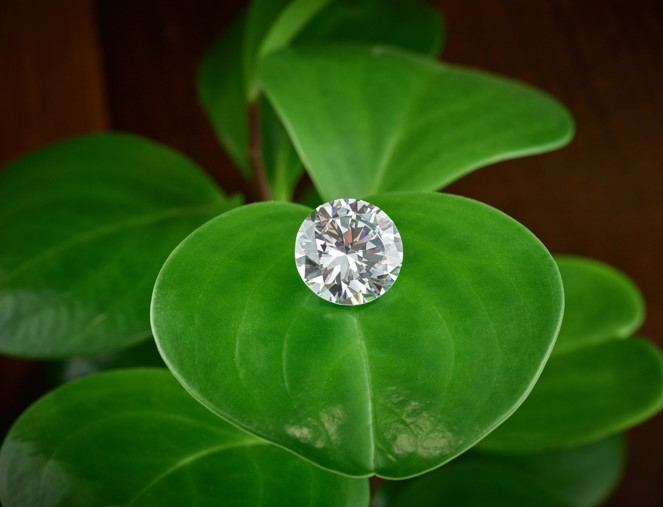Natural Vs Lab Grown- Why The Debate Over Diamonds Is Typical Of Our Attitude To Climate Warming
With lab diamonds completely indistinguishable from natural diamonds to the naked eye, it is indeed surprising that the industry continues to push natural diamonds on consumers. The oligopolistic industry has always been known for its smart marketing, but in this case, there is a real case to plan a stop date on destructive diamond mining.

Let’s talk about the diamond, a mineral which really shouldn’t be as expensive as it is. While it’s understood that precious metals like gold and silver are expensive because of their rarity and as such can command the prices they do, diamonds can be produced synthetically. The synthetic diamonds are almost as good as natural diamonds, ranking 9.25 on the Mohs Scale of hardness compared to 10. While that may seem like a large difference, it’s not noticeable in practice. Both natural and lab-grown diamonds are so far up the scale that it’s nigh impossible to scratch either through conventional means, which means that the argument for a practically superior product can’t be made.
So, what about looks? Surely the naturally occurring diamond, which takes over 3 billion years to form looks better than the man-made diamond, grown from a seed in a lab? No. Synthetic diamonds are visually indiscernible from real diamonds to the human eye and are the reason that certificates of authenticity exist to distinguish between the two now. In fact, in many ways, when it comes to the holy trinity of cut, clarity and colour in diamonds, synthetics can usually deliver much higher grades today.
With all that in place, let’s talk about the environmental impacts of a natural diamond. Throughout history, diamonds have had a bloody past. Everyone’s heard of the blood diamond and how much bloodshed is caused to mine a single diamond, even to this day. Ecologically, diamond mining has wreaked havoc throughout Africa and other parts of the world. It has caused deforestation, soil erosion and caused the relocation of the local populations. In Angola, even rivers and lakes have not been spared, with rerouting of the rivers and construction of dams causing disastrous effects on the fish and wildlife.
In certain instances, the activity of extracting diamonds can lead to the complete breakdown of ecosystems. The Kono district of eastern Sierra Leone has numerous deserted mining pits as a result of diamond mining, which has resulted in the disappearance of wildlife, erosion of topsoil, and transformation of once-arable land into an empty and barren landscape.
Reports show that to mine a 1.0ct diamond, roughly 1750 tonnes of earth is dug out, which is often not filled back due to not following regulations. When diamond mining is not conducted with care, it can cause significant disturbance to the land. This is due to the accumulation of large amounts of waste rock, sand, and soil in the surrounding areas. Appropriate management and rehabilitation of this waste is necessary, but unfortunately, some unregulated and illegal diamond mines fail to do so, resulting in the destruction and imbalance of the surrounding land. In addition to this, marine and coastal diamond mining have also led to significant excavation and modification of coastal areas.
On the other hand, eco-friendly lab-grown diamonds do not cause any harm to the environment. These diamonds are created within laboratories that follow strict environmental regulations, ensuring that they are grown in safe environments. By opting for lab-grown diamonds, consumers can support sustainable practices that do not harm the Earth. Even the electricity they consume, if sourced from renewable sources, could reduce their carbon footprint even further.
So why do customers still opt for the blood diamond? The simple answer is marketing. Natural diamonds are portrayed as “a woman’s best friend” and “forever”. Jewellers will always tell a buyer that the natural diamond is of higher quality and will always outshine a synthetic diamond. Certificates of authenticity do the same thing which NFTs did, tricking the human brain into thinking it’s got something unique, a one-of-a-kind. Since diamonds are a one-time purchase, consumers don’t think that the environmental impact on their side is too high, which is completely wrong once you factor in the emissions of multiple people doing this as a whole. Lab grown diamonds emit less than 6% the emissions of natural diamonds to create and should be the preferred shiny stone to buy, but don’t seem to be gaining traction at the speed they should.
The advantages of lab grown diamonds are many, but the main one is cost. Lab-grown diamonds cost 60-80% less than naturally mined diamonds while being the exact same carat weight and grade. Another advantage is knowing that the diamond was produced by relatively blood-free means, since the chain of supply is a lot smaller. The diamonds are grown, checked and then sold just like any other product, as compared to the lengthy supply chain that natural diamonds have to have.
In conclusion, owning natural diamonds is an odd way to flex, considering the fact that they don’t hold their value like gold and silver do. Diamonds sell for about 50-75% of the value you bought it at, which makes them a horrible investment. A diamond is normally a permanent investment, not up for sale late. Synthetic diamonds look just as pretty as natural diamonds and cost less, which makes them a much better use of money than natural ones.
Written By Yash Singh, a B.Tech Student at MUJ




